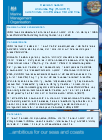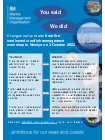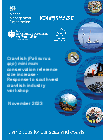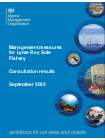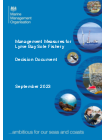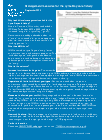Regional Fisheries Groups - South West 7efg
The region covers Worth Matravers/Saint Alban's Head around coast of Cornwall, to Bristol. This includes the Isles of Scilly.
Current projects:
- Small eyed ray project aiming to remove the non retention policy in 7e.
- New fisheries management measures are being implemented in Lyme Bay
- New fisheries management measures being considered and implemented for southwest crawfish fishery
Catch Limit Decisions
Southwest crawfish fishery
The fishing industry shared concerns regarding the recent increase in crawfish (Palinurus spp) landings coupled with an observed increase in the size of the fishery.
MMO held a co-design workshop on 3 October 2023 with fishers to discuss the current issues with the southwest crawfish fishery, and proposed options for management in the short-term. Further information on the workshop including meeting notes and outputs is available below.
MMO proposed two initial solutions in the workshop. These were:
-
An increase in the minimum conservation reference size (MCRS) from 95 mm to 110 mm in English waters of ICES area 7,
-
A seasonal closure of the fishery during the off-peak fishing period in English waters of ICES area 7.
There was unanimous agreement in the workshop to implement a MCRS increase from 95 mm to 110 mm in English waters of ICES area 7. Following this, MMO has announced a licence condition regarding this change will come into force from 1 January 2024. Further information on the rationale behind the MCRS increase is available below.
MMO also held a consultation on a potential seasonal closure of the crawfish fishery. The closure seeks to prohibit the retaining and landing of crawfish in English waters of ICES area 7 for all UK and EU vessels using all gear types. The consultation ran from 13 November to 27 November 2023.
Having considered the consultation responses, scientific evidence and socio-economic impacts, UKFAs have agreed to introduce a closure of the crawfish fishery for all UK and EU vessels in:
- English waters of ICES area 7 from 5 February to 30 April 2024.
This closure length will protect berried and juvenile crawfish whilst balancing socio-economic considerations, fulfilling EU notification obligations and allowing the shellfish industry time to adapt business processes.
The closure will be enacted via a licence variation.
Further information on a summary of responses received and reasoning behind the decision is available here.
Consultation responses and feedback from the co-design workshop indicated that further measures may be required to ensure long-term sustainable fishing of the crawfish fishery. As such MMO is considering whether additional management measures, including potential effort management, are required. A workshop to discuss potential options is due to be held in mid-February 2024 and will run alongside a consultation exercise. MMO will share further details in due course. If you wish to be involved please contact effort@marinemanagement.org.uk.
Lyme Bay Sole Fishery
Outcome of Lyme Bay sole fishery consultation and new management measures
Marine Management Organisation (MMO) has unveiled a series of measures connected to the sole fishery in Lyme Bay following a consultation with stakeholders earlier this year.
The consultation ran from 29 March to 28 May 2023 and was followed by an in-person workshop with stakeholders to discuss potential new management measures for the fishery. Further information on the consultation can be found here, with a summary of the consultation responses found below. Further information on the workshop can be found here.
Following analysis of the consultation responses, workshop and evidence investigations, MMO has published a decision document outlining the results, proposed management measures and next steps. MMO has also produced a one-pager to summarise the outcomes of consultation and proposed management measures. Please see below for the documents and further detail.
Lyme Bay - Anonymously report lost or damaged gear
In May and June 2023 a consultation and workshop were help to discuss potential new management measures for the sole fishery in Lyme Bay. One of the outcomes of the workshop was the development of this form which will help feed into a data gap on gear loss and damage in Lyme Bay.
The data collected from this form will directly feed into a meeting on the potential for temporary spatial separation between gear types in early 2024. At this meeting, the industry will be asked to decide whether they would like any measures implementing, and whether these would be voluntary.
Lyme Bay Code of Conduct
The Marine Management Organisation (MMO) has responded to concerns from fishermen that an increase in sole quota has led to conflict and potentially overfishing in Lyme Bay.
The MMO and Inshore Fisheries Conservation Authorities (IFCA) have been investigating the issue and in 2022 created a steering group to oversee the investigation. The Steering group includes representative fishers from the Lyme Bay Community Interest Company, and other ports outside of Lyme Bay, as well as the Department for Environment, Food and Rural Affairs (Defra), IFCA, Centre for Environment, Fisheries and Aquaculture (Cefas) and MMO representatives.
At a recent steering group meeting in the summer of 2022, a best practice Code of Conduct for sole fishing with gill nets in Lyme Bay was agreed as follows. Lyme Bay is defined as the area inside a line from Beer Head to Portland.
- A minimum mesh size 5 inches (127mm) for gill nets targeting sole.
- All fixed nets should be marked with a buoy showing the PLN of the vessel at both ends of the net.
- Flags and radar reflectors are used where possible and practical to mark the location of nets.
Note: That these are best practice recommendations and not law.
The first recommendation is to support the sole population by letting smaller soles increase their opportunity to breed. The second is to help prevent gear conflict by increasing the visibility of net locations to prevent them being caught up in trawl gear, and so that other netting vessels can avoid setting nets that cross over nets already set in the water.
The MMO is working with Cefas and other organisations to develop a scientific investigation into what impact increased fishing in Lyme Bay may be having on sole populations, the marine environment, and the potential socio-economic impacts on fishers. This work involved the use of MMO data from logbooks, the Catch App and from observers at sea and in fish markets, to analyse catches made by different vessels as well as other possible work to look at the wider sole population. The results of this work can be found in the Cefas report – common sole in Lyme Bay.
Successes in the South West 7efg:
1. Small eyed ray (RJE) investigation to explore removal of 7e non-retention
This was the first project to come from the RFGs. Inshore fishers in the Southwest Regional Fisheries Group raised the local abundance of small-eyed ray in area 7.e and the rationale behind the non-retention policy in 7.e when it can be retained in 7.f-g. The non-retention policy is the result of a political decision at EU level, it was not based on ICES advice.
The MMO commissioned Cefas to carry out a study, this was paid for by MMO evidence team. The study highlighted that there is no evidence of decline in the stock, distribution is patchy as is trawl survey data due to its preferred habitat. Small-eyed ray is not a significant stock nationally or financially but could be significant to coastal communities in the southwest particularly inshore fishers.
Currently the Defra negotiations team are taking this to the EU at the annual negotiations in December 2022 with the hope of getting an allowance. We will keep the group updated.
2. Grants FaSS match rates on Health & Safety funding
The NW RFG raised the disparity between the amount for grant funding available for bottom towed gear and other gear types.
The Defra FaSS team bought a paper to the board asking for the match-funding rates of fishing vessels which are classed as micro entities to be raised to 80% for Health & Safety projects regardless of the type of fishing gear used. This would bring them in line with the rate available to small-scale coastal fishers (SSCF).
Following discussions within this group and with the HM Treasury, the change has been approved: match-funding rates for any vessel with a length of 12m or less will be raised to 80% for Health & Safety projects, regardless of the type of gear used.
3. Additional Quota 2021 round
Additional Quota was made available from the MMO at the end of 2021. The one-time offer meant a small amount of the additional quota England received from the Trade and Cooperation Agreement was distributed via selected Producer Organisations (PO) without cost to the U10m vessel or benefit to the PO. It enabled capped vessels to fish above their annual 350kg limit for quota stocks before January 1 2022.
4. Additional Quota 2022 round
A similar scheme took place again in 2022 starting earlier in the year.
Temporary lift of the under-10m licence cap from 1 August 2022.
The cap on some under-10m vessels which restricts their uptake to no more than 350kg per year of quota stocks was temporarily lifted for the remainder of 2022. This is being done to facilitate uptake of available quota and as an exercise to make an initial test for any unexpected consequences of lifting the cap more permanently.
Offer of additional quota to vessels with Category B and C licences.
The MMO opened a window for vessels with Category B & C licences to apply for access to additional quota. Over 10m vessels with Category B or C licences have a limited number of quota stocks for which they can fish. Under this scheme, these vessels can apply for access to more opportunities for the remainder of 2022.
It enabled vessels with Non-Sector Category B or C licences to fish above their current limits for quota stocks before 1 January 2023.
Meeting notes:
Collaborative Science:
Quota Presentations:
Last updated
-
Update 25-01-24
-
Catch limit decisions added
-
Consultation update
-
Small amend
-
Update
-
Update of Lyme Bay sole fishery consultation and new management measures
-
Attachment updated
-
Anonymous reporting form added
-
Meeting notes updated
-
26 April 2023 update.
-
Feb update
-
RFG update
-
Successes added
-
New date
-
Code of conduct update
-
First published.
